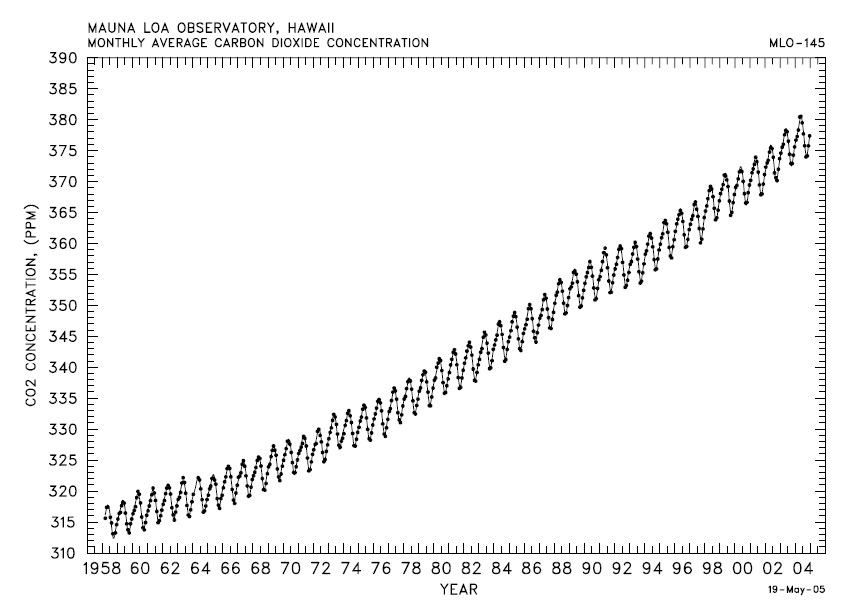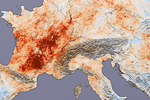
The ongoing decline in Arctic sea ice hit a new record this year that rocked even the most pessimistic predictions. The low sea ice extent hit 18 percent below the previous record set in just 2007, and was only around half the size it was in 1980. Here, NASA satellites catches a glimpse of the vanishing ice on September 13th, 2012. Image courtesy of NASA.
This year saw the Arctic sea ice extent fall to a new and shocking low, while the U.S. experienced it warmest month ever on record (July), beating even Dust Bowl temperatures. Meanwhile, a flood of new research has convincingly connected a rise in extreme weather events, especially droughts and heatwaves, to global climate change, and a recent report by the DARA Group and Climate Vulnerability Forum finds that climate change contributes to around 400,000 deaths a year and costs the world 1.6 percent of its GDP, or $1.2 trillion. All this and global temperatures have only risen about 0.8 degrees Celsius (1.44 degrees Fahrenheit) since the early Twentieth Century. Scientists predict that temperatures could rise between 1.1 degrees Celsius (2 degrees Fahrenheit) to a staggering 6.4 degrees Celsius (11.5 degrees Fahrenheit) by the end of the century.
Despite this, governments around the world have been slow to tackle climate change; global greenhouse gas emissions continue to rise year-after-year. In many ways policies are going backwards: Germany, one of the world’s greenest top economies, is looking at increasing its use of coal; Canada has abandoned the Kyoto Treaty and its government is fully committed to bringing its tar sands to a global market; big oil companies are now drilling in the melting Arctic for more fossil fuels; and the race for the U.S. presidency has had nary a mention of climate change. The lack of movement on the issue politically has meant that some scientists are looking toward other options to combat climate change once the damage becomes undeniable, including hugely-controversial geo-engineering ideas. But a recent study in the Proceedings of the National Academy of Sciences (PNAS) argues for a bold, and perhaps less dangerous approach than geo-engineering ideas: physically pull carbon out of the atmosphere.
“If climate change is quicker than expected, then the world has likely overshot the acceptable limit of carbon dioxide in the atmosphere or will go over before emissions can get stopped,” Klaus Lackner, lead author of the paper with the Earth Institute at Colombia University and board member of atmospheric carbon-capturing company, Kilimanjaro Energy, told mongabay.com. “Unlike flue gas scrubbing [which removes emissions from power plants], air capture can remove more carbon dioxide than is emitted. Therefore, it can gradually reduce CO2 levels in the atmosphere; not overnight, but a lot faster than nature will do it by itself.”
The big draw for capturing carbon from the atmosphere is that on a massive-scale it could theoretically turn the current situation around. Global society is now putting extra carbon into the atmosphere every year to the tune of around 30 billion metric tons, but air-based carbon capture on a large-scale could actually produce negative emissions by pulling more carbon out than is being emitted, and theoretically re-cool the planet a lot faster than waiting for current carbon emissions to leave the atmosphere naturally. Carbon can hang around in the atmosphere for centuries before being sequestered by the oceans or vegetation.
A second argument in its favor: capturing carbon from the atmosphere could deal with trickier emissions outside of power plants, i.e. transportation emissions from cars, planes, and ships.
“Air capture can compensate for any emission. Some emissions can be reduced with better or more economic options (including better efficiency), but some emissions are very hard to get rid of,” Lackner explains. “It may only be used for ten percent of the problem, but those ten percent are the hardest ten percent.”
While the technology has been held up by development issues as well as projected costs, Lackner is convinced these hurdles can be overcome.
Fake forests

Tree in Colombia. Photo by: Rhett A. Butler.
But how does it work? The process of capturing carbon from the atmosphere has been described as “artificial trees,” since the technology would likely employ towers that essentially absorb carbon from the atmosphere, much like forests do naturally. The carbon would be absorbed by “sorbents”–a special material that would entrap diffuse carbon from the atmosphere in large quantities. Although the technology would require both energy and water, the carbon towers would capture far more carbon than they would produce and, if powered by renewable energies, would emit zero carbon.
Experts have long looked at standing, natural forests as one way to mitigate climate change, given their effectiveness in storing carbon. However the knowledge that forests are an efficient way to mitigate climate change has not stopped them from falling worldwide. Artificial carbon towers would theoretically be more powerful at pulling carbon out than forests, giving the world a more potent, and quicker tool, for carbon sequestration. This is not to say efforts to protected the world’s forests are in vain. Forests provide far more services to humankind than just carbon storage, including biodiversity, water purification, soil health, erosion control, and others. In the end, a combination of smart policies to keep natural forests standing and the technology of “artificial trees” may be employed together to mitigate climate change.
Already the scientists anticipate producing these small towers on a mass scale, writing in the PNAS paper that “in terms of weight and complexity, such a unit would be similar to a car.” There are around a billion cars in the world today. Of course, the process of building an army of carbon trapping towers will have its own environmental footprint and, depending on the energy used for construction, a possible carbon footprint as well. But these impacts can’t be known until companies begin mass manufacturing a select design.
The paper further argues that with the proper urgency and political will, it could take only a decade for such carbon capture technologies to reduce the “rate of CO2 in the air comparable to today’s emission rate.” But to bring the planet back down to 350 parts per million of CO2–a concentration many scientists recommend to return the Earth’s atmosphere to stability–the researchers estimate that about 50 years would be necessary.
From atmospheric carbon to liquid fuel?
Once the carbon is captured by these absorbing towers, researchers see two options: one is to store the CO2, while the other is to recycle it back into a liquid fuel that could be used as a new energy source.
“The CO2 can be stored in deep saline formations, or be converted with certain minerals into a solid carbonate that can be stored safely and permanently,” Lackner explains. “As long as the world uses fossil fuels it needs carbon storage. Air capture can work with any carbon storage method but has the advantage that it can use remote storage sites.”
But there is also a more radical idea. Its feasible that captured CO2 could be recycled back into liquid hydrocarbon fuel, ending the need for fossil fuels altogether.
“For every ton of carbon taken from the air, another ton of carbon is re-energized to fuel,” he explains. “Now we can drive cars and air planes without lugging around batteries and without getting oil out of the ground.”
Once the carbon is captured by the sorbents, one could employ solar power to combine the CO2 with hydrogen from water, creating liquid fuel. According to Lackner, this recycled fuel could be used when solar isn’t viable, i.e. at night, or to power cars, airplanes, and ships. Such a fuel-loop system would have numerous knock-off benefits, including no more oil spills, mountain top mining, fracking, or tar sands; no more conflict over protected areas or indigenous lands and fossil fuel extraction; no more global economy dependent on localized fossil fuel sites.
Still Lackner cautions that “for this to work renewable energy, even more than air capture, would need to get cheaper.” This is because in order for the technology to work efficiently, it would need to depend on green energies, like solar, instead of simply using fossil fuels to create more fossil fuels.
Cost Issues

Atmospheric carbon dioxide levels from 1958-2008. Click to enlarge.
The cost of atmospheric carbon capture is currently its biggest obstacle with projected costs stymying more robust investments in research and development. But, Lackner says current cost estimates are entirely untrustworthy given that most technologies become considerable cheaper once design and efficiency hurdles are overcome.
“Solar energy got at least one hundred times cheaper than it was in its early days. Wind energy also became a lot cheaper. If those high prices in the early days would have scared researchers away these options would have never been developed,” he notes. “If the world had listened to such predictions, jet planes would have never been built.”
Last year a report by the American Physical Society (APS) dampened hopes for atmospheric carbon capture by estimating the costs at $600 per metric ton of CO2. In his PNAS paper, however, Lackner and colleagues contend that estimates regarding the technology are hugely volatile, ranging from a high of $1,000 per metric ton of CO2 to just $30.
“An accurate estimate today of future costs is simply impossible; a system that can be built now should be seen as a straw man to be replaced with improved designs,” the researchers write, adding that, “Not surprisingly, cost estimates of novel technologies have often been wrong. The costs of new technologies can drop by orders of magnitude as they develop and mass production ensues.”
In other words, the researchers argue that estimated costs today, rather high or low, should not stop ongoing research and development into a technology that could play a major role in stabilizing the climate. In addition, if history is any guide, once researchers develop a commercially feasible design the cost could very well plummet. In addition, if recycling the carbon into fuel becomes viable that would produce an extra economic incentive. But, given the technology is still in its youth, all of this is thinking big.
“The [carbon capture and storage] research community today seems more focused on incremental improvements that allow for defendable cost estimates of a technique than on experiments with more innovative concepts,” the researchers write. This timidness has been exacerbated by an early U.S. Department of Energy target cost of $3 per ton of CO2 for carbon capture technologies, a target that the scientists dub “unreasonable.”
Finally, acceptable costs for the technology could shift rapidly once the scale of climate change, and its toll on the global economy and welfare, is fully understood.
“If climate change were universally perceived as a serious calamity, air capture as an emergency measure might be valuable at costs much higher than $100/t CO2,” the researchers write.
Not an excuse
The potential benefits of atmospheric carbon capture should not lull society into complacency regarding climate change, adds the study’s authors. For one thing, there remain too many uncertainties about the technology and its eventual cost; for another thing, time is not on our side.
“The available time [to avoid catastrophic climate change] is short and actions are necessary on all fronts,” the researchers write. “Carbon
mitigation costs will not come down until action is taken.”
Not only must society begin to far more aggressively slash carbon emissions, but it should start investing more into promising mitigation techniques that stave off complete climate disaster, according to the writers.
“Learning by doing won’t happen without doing,” Lackner says. “Therefore the next step is to use air capture in commercial applications that need CO2.”
CITATION: Klaus S. Lackner, Sarah Brennan, Jürg M. Matter, A.-H. Alissa Park, Allen Wright, and Bob van der Zwaan. The urgency of the development of CO2 capture from ambient air. PNAS. 2012. www.pnas.org/cgi/doi/10.1073/pnas.1108765109.
Related articles
September tied for world’s warmest on record
(10/16/2012) September 2012 tied with 2005 for the warmest on record around the globe, according to new data released by the National Oceanic and Atmospheric Administration (NOAA). The average land and ocean temperature was 16.27 degrees Celsius (61.31 degrees Fahrenheit) for this September, 0.67 degrees Celsius (1.21 degrees Fahrenheit) above the 20th Century average for the month. Shockingly, this is the 331st month in a row that has been above the 20th Century average.
Norway to double carbon tax on oil industry for climate change programs
(10/15/2012) Beginning next year, Norway will nearly double the carbon tax on its domestic oil industry to help set up a $1 billion climate change fund for programs in developing nations among other green projects. The Scandinavian nation is the world’s 13 largest oil producer and third biggest oil exporter, yet has been one of the most active champions of funding climate change projects.
Over 70 percent of Americans: climate change worsening extreme weather
(10/10/2012) According to a new poll, 74 percent of Americans agree that climate change is impacting weather in the U.S., including 73 percent who agreed, strongly or somewhat, that climate change had exacerbated record high temperatures over the summer. The findings mean that a large majority of Americans agree with climatologists who in recent years have found increasingly strong evidence that climate change has both increased and worsened extreme weather events.
Nary a mention of climate change during U.S. presidential debate
(10/04/2012) The hour-and-a-half long debate between President Barack Obama and ex-governor Mitt Romney last night ended without a single reference to climate change. Frustrated with the lack of discussion on the issue from both candidates, environmental activists sent a petition with over 160,000 signatures to debate moderator, Jim Lehr, urging him to ask a question about climate change. The petition fell on deaf ears.
Arctic sea ice is ‘toast’ as old record shattered
(09/19/2012) Some twenty days after breaking the record for the lowest sea ice extent, the Arctic sea ice has hit a new rock bottom and finally begun its seasonal recovery. In the end, the Arctic sea ice extent fell to just 3.4 million square kilometers (1.32 million square miles) when only a few months ago scientists were wondering if it would break the 4 million square kilometers. The speed of the sea ice decline due to climate change has outpaced all the computer models, overrun all expert predictions, and shocked even the gloomiest scientists.
Wind can power the world, says two new studies
(09/10/2012) Wind power is up to the challenge of providing more-than-enough energy for global society, according to two new and unrelated studies. Both studies, one published in Nature Climate Change and the other in the Proceedings of the National Academy of Sciences (PNAS), found that wind power from surface winds alone could produce hundreds of terrawatts (TW) meanwhile current global society uses around 18 TW.
Sea ice falls to record low with over two weeks of melting left
(08/27/2012) One of the most visible impacts of climate change—melting summer sea ice in the Arctic—just hit a new milestone. Scientists with the U.S. National Snow and Ice Data Center (NSIDC) have declared that this year’s Arctic sea ice extent dipped below the previous record set in 2007 as of yesterday. The record is even more notable, however, as it occurred more than a fortnight before the Arctic’s usual ice melt season ends, meaning the old record will likely not just be supplanted, but shattered.
Fourth warmest July yet around the world
(08/20/2012) Last month was the fourth warmest July in the record books going back to 1880 worldwide, according to new data released by the National Oceanic and Atmospheric Administration (NOAA). It was notably warmer in the Northern Hemisphere than in the South: the month was the warmest July ever in the North. Worldwide temperatures were 0.62 degrees Celsius (1.12 degrees Fahrenheit) above the 20th Century average.
(08/16/2012) Four weeks before Greenland’s melting season usually ends, it has already blown past all previous records. By August 8th, nearly a month before cooler weather usually sets in around the world’s largest island, the island toppled the past record set in 2010.
United States ranks near bottom on first ever energy efficiency scorecard
(08/15/2012) Last month, the American Council for an Energy Efficient Economy released its first ever international energy efficiency scorecard, which gave the United Kingdom the top score. Using data points honed over years of rating U.S. states, the organization hoped to inspire nations to learn from each others’ effective policies, as well as encourage “friendly competition” in the spirit of lowering global carbon emissions. At number one, the United Kingdom achieved a score of 67 out of 100 points, followed by Germany, Italy and Japan. As a whole, the European Union tied with China and Australia, and nine points below them, the United States came in with a score of 47 out of 100.
July 2012: hottest month in U.S. history

(08/08/2012) Last month was not only the hottest July in U.S. weather history, but the hottest month ever recorded in the contiguous U.S, besting a record struck in July 1936 during the Dust Bowl, according to new data from the National Oceanic and Atmospheric Administration (NOAA). The average temperature last month over the contiguous U.S. was 77.6 degrees Fahrenheit, or 3.3 degrees Fahrenheit above the 20th Century average. Making matters worse, crippling drought continued to spread over 63 percent of the lower 48 states.
Climate and culture: abrupt change and rapid response

(08/06/2012) As the world experiences record heat, increased drought and fires, unprecedented ice melt and similar extreme weather anomalies decades before expected, climatologists have been forced to reconsider previous climate change projections and research techniques. Less than a decade ago, scientific consensus considered warming of more than 2 C and atmospheric levels of carbon dioxide near 450 parts per million (ppm) as acceptable or “safe”. Revised climate science literature and expert opinion now regard safe atmospheric levels of carbon dioxide as below 350 ppm, or less than 1 C rise in average planetary temperature. Many researchers and environmentalists, however, recognize that the present deviation from pre-industrial temperatures of 0.8 C may be unacceptable to prevent runaway climate change and widespread disasters.
Earth’s ecosystems still soaking up half of human carbon emissions

(08/06/2012) Even as humans emit ever more carbon dioxide into the atmosphere, Earth’s ecosystems are still sequestering about half, according to new research in Nature. The study finds that the planet’s oceans, forests, and other vegetation have stepped into overdrive to deal with the influx of carbon emitted from burning fossil fuels, but notes that this doesn’t come without a price, including the acidification of the oceans.
Extreme heatwaves 50 to 100 times more likely due to climate change

(08/05/2012) A recent rise in deadly, debilitating, and expensive heatwaves was caused by climate change, argues a new statistical analysis published in the Proceedings of the National Academy of Sciences (PNAS). Climatologists found that extreme heatwaves have increased by at least 50 times during the last 30 years. The researchers, including James Hansen of NASA, conclude that climate change is the only explanation for such a statistical jump.